Not Another Boring Thanksgiving Wine Pairing Article
Chapter Nine, Part Four.
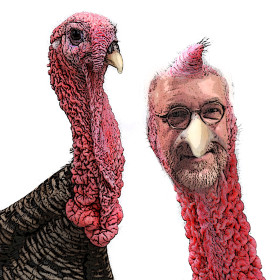 On Thanksgiving my family comes together, shares some wine, enjoys a harvest feast, and watches football, football, and more football. It’s an afternoon filled with aggressive, smash-mouth offence and bold defensive maneuvers. Then we turn on the TV and watch the game.
On Thanksgiving my family comes together, shares some wine, enjoys a harvest feast, and watches football, football, and more football. It’s an afternoon filled with aggressive, smash-mouth offence and bold defensive maneuvers. Then we turn on the TV and watch the game.
Cooking a Thanksgiving meal for 20 people can be a lot of work and very stressful for everyone involved, by which I mean my wife. Of course I help out in a big way as I’m in charge of the wine and stay far from the kitchen. That probably doesn’t sound like much help to you, but then you haven’t been at my house when the wine locusts arrive. The eighth plague was nothing compared to what happens when my people are thirsty.
My wine selection process is simple. I sit on the front porch and sample wine before the guests arrive. Last year the first wine I tasted was so good that I drank the whole bottle. I wasn’t alone mind you, there were lots of people driving by.
Don’t get the wrong idea. I have a lovely family. In fact I love my wife’s brother like a brother-in-law. We gather around the table and I take a heart-warming look at the family, my Uncle Ralph, the turkey, and then my wife brings in the bird. No casual attire at this table. No sir, even the greens are collard.
Read MoreThe Cumulative Effect In Food And Wine Pairing.
Chapter Nine, Part Six.
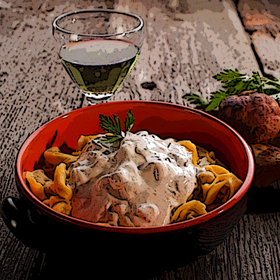 When pairing food with wine the cancellation effect works to your advantage once you understand how to balance the taste or texture of sweet and acidic food with similar traits in wine. While acidity and sweetness cancel each other out when combined on your palate, bitter and piquant sensations accumulate and magnify one another. The same can be said for pairing low acid foods with low acid wines so I’ll go ahead and say it; creamy or fatty traits do not cancel each other out; they accumulate on your palate (and also on your waistline). So after many years of deliberation I’ve decided to call this the cumulative effect.
When pairing food with wine the cancellation effect works to your advantage once you understand how to balance the taste or texture of sweet and acidic food with similar traits in wine. While acidity and sweetness cancel each other out when combined on your palate, bitter and piquant sensations accumulate and magnify one another. The same can be said for pairing low acid foods with low acid wines so I’ll go ahead and say it; creamy or fatty traits do not cancel each other out; they accumulate on your palate (and also on your waistline). So after many years of deliberation I’ve decided to call this the cumulative effect.
The Umami Tsunami.
Chapter Eight, Part Three.
One + One = Three (The Synergy Of Umami).
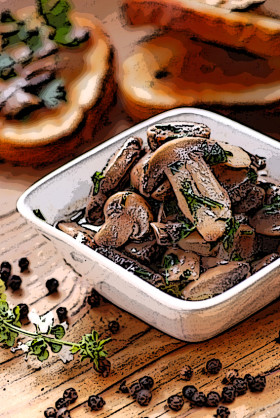 The subtle, savory fifth taste known as umami was first identified by Japanese scientist Kikunae Ikeda in 1907. In researching umami he discovered that it was linked with the amino acid glutamate and his investigations led to the development of monosodium glutamate (MSG) as a flavor enhancer. I could feed you lots of material about the development of umami-rich MSG but you would just be hungry for more in an hour.
The subtle, savory fifth taste known as umami was first identified by Japanese scientist Kikunae Ikeda in 1907. In researching umami he discovered that it was linked with the amino acid glutamate and his investigations led to the development of monosodium glutamate (MSG) as a flavor enhancer. I could feed you lots of material about the development of umami-rich MSG but you would just be hungry for more in an hour.
The umami tsunami began in earnest six years after Ikeda’s discovery when his follower Shintaro Kodama learned that glutamate, when combined with nucleotides, creates a dramatic flavor enhancing synergy. For example, when meat (high in the nucleotide inosinate) is combined with glutamate-rich foods like tomatoes or cheese, a significant umami boost is created. To understand the power of this synergy, think of the flattering outcome when you add cheese to a hamburger or braciola to tomato sauce (or as we say in New Jersey, you put the bruh-johl in the gravy).
Read MoreIn Search Of Umami.
Chapter Eight, Parts One & Two.
Where Have You Been All My Life?
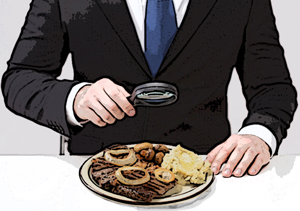 Sweet, sour, salt, bitter … sweet, sour, salt, bitter. I repeated those words at so many events for so many years that the phrase was like my own personal mantra, rooted in my psyche by daily visits to the Deli Lama. Just imagine my concern when I learned of umami – the existence of a fifth taste was surely going to throw off my mantra rhythm. Sweet, sour, salt, bitter … UMAMI? It has a good beet but you just can’t trance to it.
Sweet, sour, salt, bitter … sweet, sour, salt, bitter. I repeated those words at so many events for so many years that the phrase was like my own personal mantra, rooted in my psyche by daily visits to the Deli Lama. Just imagine my concern when I learned of umami – the existence of a fifth taste was surely going to throw off my mantra rhythm. Sweet, sour, salt, bitter … UMAMI? It has a good beet but you just can’t trance to it.
Not only did this secretive fifth taste exist, it existed right under my nose – where my mouth is conveniently located. I knew if I was ever going to get my mantra groove back I needed to embrace the mystical taste I’d overlooked for so long. I gathered articles and books on the subject and soon learned that describing the taste of umami is like describing the flavor of wine, it’s just so many words on a page. Umami, like wine, must be experienced to be understood.
Read MoreThe Wine Tasting Stream of Consciousness.
Chapter Four. Part Three.
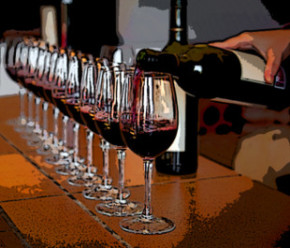 It’s wine tasting season in New York once again. A season-ending injury kept me out of the fall tasting line-up and at the first spring event I started slurring my speech, dropped several wine glasses and fell down twice. I became disoriented, dizzy and incoherent so I did the only sensible thing.
It’s wine tasting season in New York once again. A season-ending injury kept me out of the fall tasting line-up and at the first spring event I started slurring my speech, dropped several wine glasses and fell down twice. I became disoriented, dizzy and incoherent so I did the only sensible thing.
I drove myself straight home.
Years ago, when I first started attending wine tastings, I developed an olfactory/gustatory associative process to try to pinpoint the flavors and aromas that seemed so familiar yet so elusive. The first time I recognized the taste of vanilla in a red wine is a good illustration of how this free flowing stream of consciousness unfolds.
Read More



















